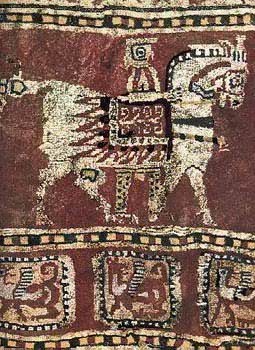|
The dazzling beauty and excellent quality of Persian carpets are well known all over the world. Undisputedly, this traditional fine art has always been a central core of Iranian history and culture within the past few thousand years.
Over the centuries, carpet has become one of the most important symbols of the ancient rich culture of Iran and has played a key role in the everyday life of Iranians. On the carpets, Iranians are born, live and raise their families. In each and every home in Iran, rich or poor, one can always find a carpet, which might be old and worn out or very precious. Due to the very close connection between man and carpet over the centuries, carpet reflects the Iranian culture and arts of various historical periods and portrays the related designs, patterns and colors.

Having in mind the ever increasing momentum of communication and exchange of information in recent years, it seems very essential for preserving the valuable qualities of this traditional and ancient Iranian fine art and to serve as a means for introducing it to the general readers as well as enthusiastic students and researchers.
We would effectively contribute to a greater degree of understanding and appreciation of the Persian carpet by a larger number of people throughout the world.
Carpet-weaving is undoubtedly one of the most distinguished manifestations of Iranian culture and art, dating back to the Bronze Age, but as the materials used in carpets including wool and cotton, decay into dust during the course of time, archaeologists couldn't make any special discovery during the archaeological excavations. What have remained for us from the early ages as evidence of carpet-weaving are nothing more than a few pieces of worn-out rugs.
Such fragments do not help very much in recognizing the Carpet-weaving characteristics of pre-Seljuk period (13th and 14th centuries AD). Ag the oldest pieces discovered are those found in eastern Turk Stan, dating back to the third till fifth centuries AD , and also some of the hand-weavings of the Seljuk's of Asia minor on exhibit in Alameda Mosque in Kenya and Ashrafoghlu mosque in Beyshehir, Turkey. These pieces attracted the attention of researchers earlier this century, and now they are kept in the museums of Turkish and Islamic Art in Istanbul and the Mowlana museum in Konya
In a unique archaeological excavation in 1949, the exceptional Pazyryk carpet was discovered ag the ices of Pazyryk Valley, in Altai Mountains in Siberia. It was discovered in the grave of a Scythian prince by a group of Russian archaeologists under the supervision of professor Rudenko. Radiocarbon testing revealed that Pazyryk carpet was woven in the 5th century BC. This carpet is 1.83x2 meters and has 36 symmetrical knots per square centimeters. The advanced weaving technique used in the Pazyryk carpet indicates a long history of evolution and experience of this art. Most experts believe that the Pazyryk carpet is the final achievement of at least one thousand years of experience and history. According to this theory the art of carpet-weaving in Iran is at least 3500 years old.
In 1978, the founders of the Carpet Museum of Iran established this museum with a limited number of Persian carpets and kilims, in order to revive and develop the art of carpet-weaving in the country, and to provide a source to satisfy the need for research about the historical background and evolution of this art.
The Carpet Museum of Iran, with its beautiful architecture and facade resembling a carpet-weaving loom is located on the northwest of Laleh Park in Tehran. It is composed of two exhibition galleries covering an area of 3400 m'. The ground floor gallery is assigned to permanent exhibitions and the upper floor gallery is considered for the temporary exhibitions of carpets, kilims ailed carpet designs.
At the beginning, the museum's collection consisted of 275 pieces of exquisite carpets and kilims, bought from dome and foreign markets, and obtained from different museums such as Golestan Palace Museum.
The most precious Persian carpets of the 16th through to the present century make the collection of the Museum providing a very rich source for researchers. After the Islamic Revolution, the museum's collection got richer because the exquisite carpets of the Saad Abad Palaces and the state organizations were transferred to the museum.
Many of the masterpieces woven in the important
carpet-weaving centers of Iran such as Tabriz, Isfahan, Kashan, Khorasan , Kerman, Kurdistan and the tribal regions are permanently exhibited in the ground floor gallery of the museum.
|